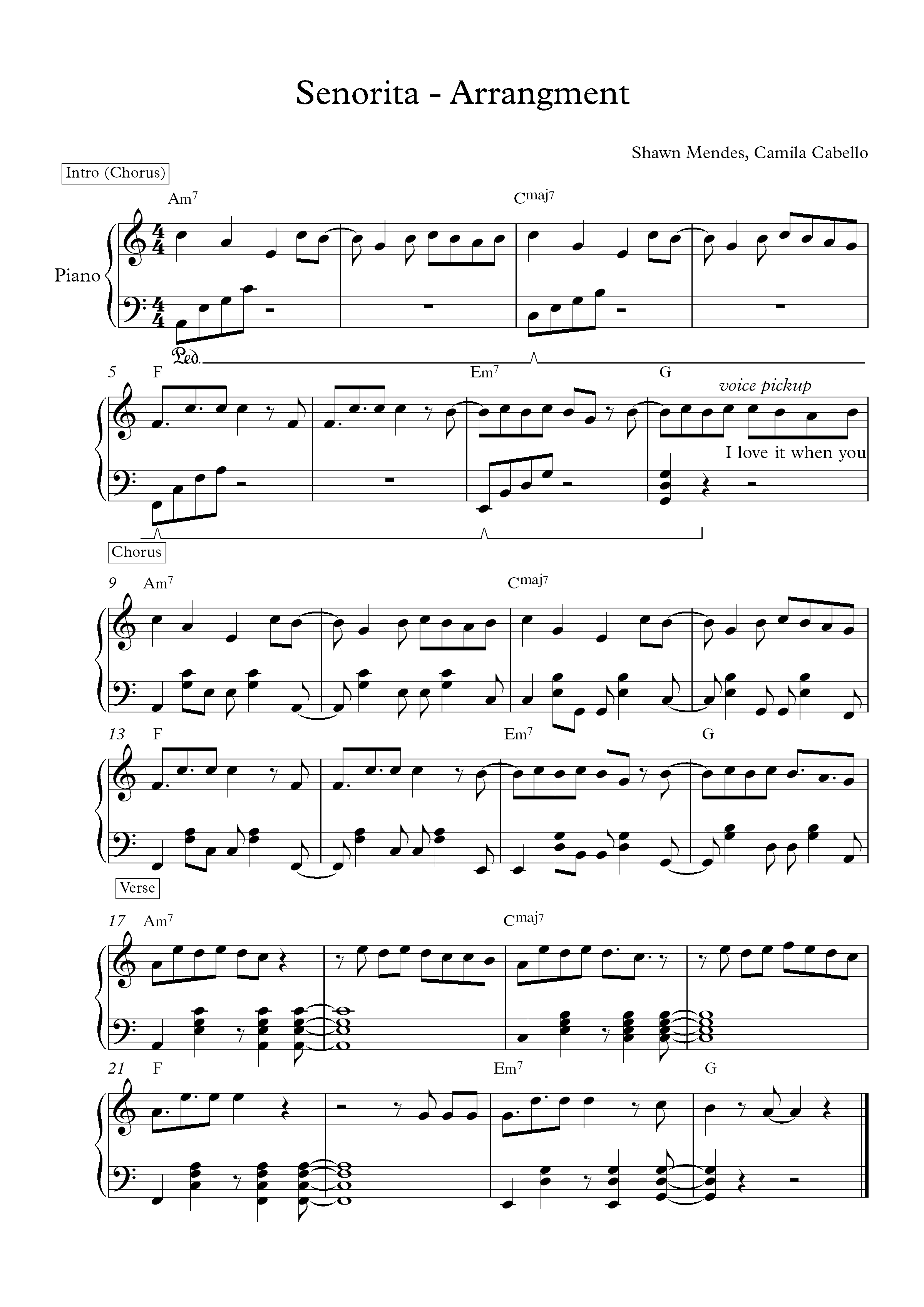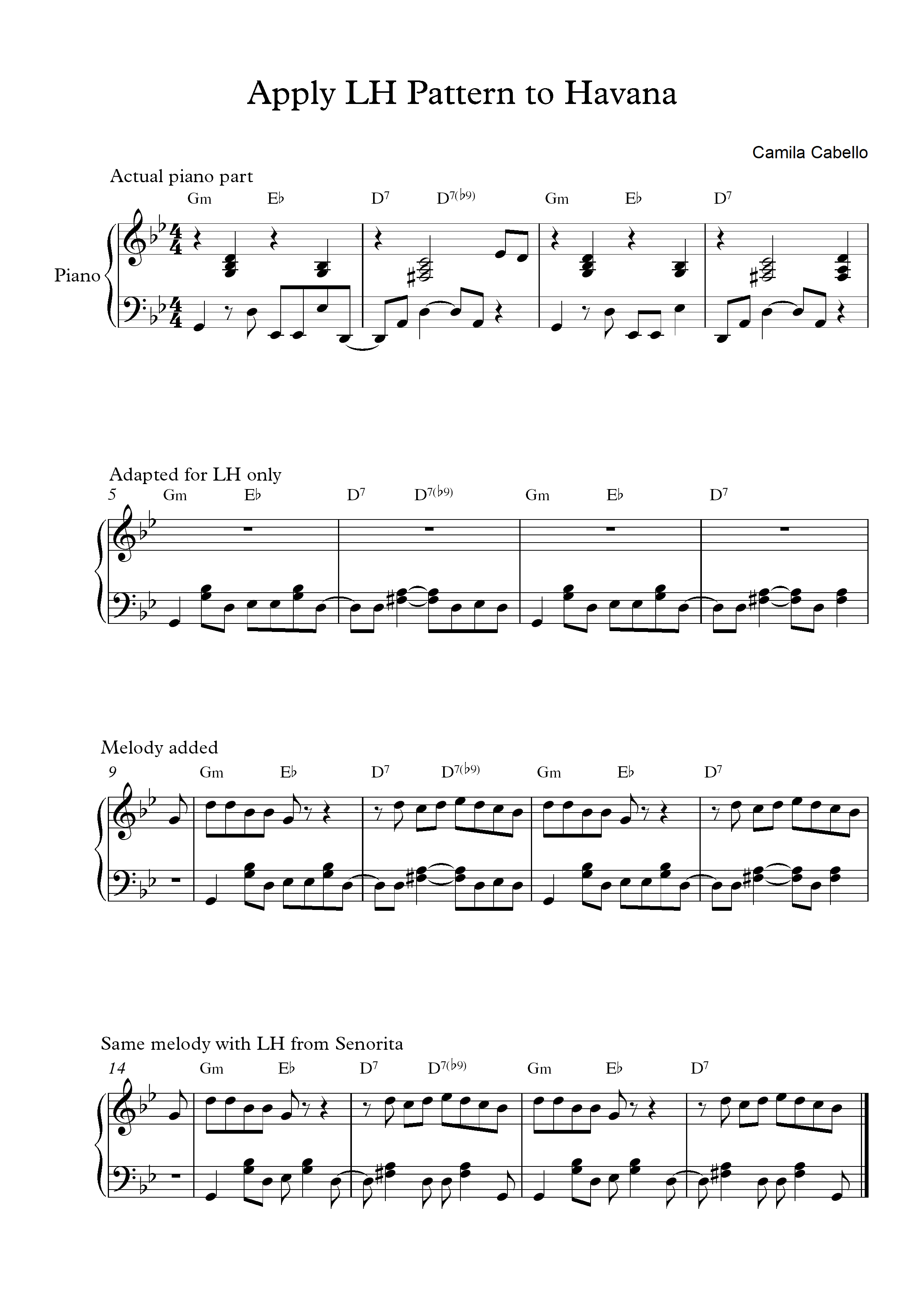What to do with your transcriptions – Applications
Lesson goal: become more familiar with the many ways to use transcription to improve as a musician
Not only is transcribing music a great way to improve aurally as a musician, but it is a gateway to a number of practice routines and techniques that are otherwise inaccessible. This lesson is designed to outline some of these routines and techniques.
Although this course focuses on the process of transcribing a piece of music, many, myself included, would argue that merely transcribing a piece of music is of little benefit to the aspiring musician and would emphasize the importance of practicing, applying and internalizing what you have transcribed. Here are several ideas on how to follow up a transcription:
Surface Level
i) Simply play along to the piece.
Use technology to slow down the piece if it is too fast for you at the start. Slowly work your way up to tempo. Even try playing above tempo if appropriate. Use technology to loop difficult sections.
ii) Make a simple arrangement/cover of the piece.
If you play a chordal instrument you could play the chords using an accompaniment pattern and then either sing the melody or if you are playing piano play it in your right hand (with the accompaniment in your left hand).
Second Level
iii) Play the transcription imagining the actual recording playing in the background.
Try playing once with a metronome. Try recording yourself and judging how close to the actual piece it sounds. Maybe even compare with a recording of yourself playing with the music in the background from i)
This is especially beneficial for singers or instrumentalists who deal with intonation.
iv) Play the transcription in a different key.
You can either play solo or use technology to change the pitch of the piece and play along with it. Depending on the piece and what you have transcribed transposing it can become very difficult very fast. However, if you want to learn say the chord progression to a song, or the main melody of a song this is one of the best ways to learn and even memorize it. Remember to always think in numbers (functional harmony) and to keep a consistent tempo when practicing in a new key.
v) Practice licks and patterns and apply them to other songs.
Great exercise – probably the most natural way to follow up a transcription! Take a small part of a transcription, an opening riff to a song, a chord progression/elaboration of a chord progression, an accompaniment pattern, a phrase from a solo, a drum fill, really anything that sparked your interest upon listening to the piece and play it in isolation. Give your own unique ‘name’ to it, for example: The John Bonham fill, or The Chromatic Creeping Chords from I to IV. Play it in every key. Vary the tempo. Choose a piece in a similar style and find as many points in the song where the lick/pattern is applicable. Practice the piece that way. Incorporate the lick/pattern into one of your compositions or more generally into your improvisation. Try not to get carried away though – especially when performing!
vi) Check your transcription against another transcription or a score.
Be careful of garbage on the internet! There are a lot of transcriptions that are inaccurate. Just like the internet is full of information that is inaccurate… But not what I write… But at the end of the day your ears are the best judges. Try to find professional looking transcriptions that are of the exact recording that you transcribed. Avoid arrangements. Once you have a transcription/score, visually check yours against it – note for note. Circle any discrepancies. Check each with the recording without playing them first and then second playing them along with the recording. Try to take note of what kind of mistakes you usually make and if you can try to figure out why you made those mistakes. Maybe you often miss the first note of phrases that starts on a note outside the key and perhaps a solution is to focus on the first note of every phrase even if it seems insignificant (an unaccented chromatic neighbor tone). This is a great way to dive deeper into the subtleties of classical music – especially since scores are readily available at websites such as imslp.
High Level
vii) Learn different artist’s styles, harmony choices, licks/phrases.
Make a small profile for each artist. The best way to do this is to do several transcriptions of the same artist. Try to find what it is that you like about his/her music. Research the player and the style of music that they play. Try to play some songs you know pretending that you are him/her.
viii) Sing/scat a solo or difficult melody (even if you are not a vocalist).
Don’t worry about how you sound. Stay in tune and in time though. First try to sing/scat along with the piece while also playing the melody on your instrument (if this is possible). Next try to sing along to the piece while not playing the melody. You can slowly transition to this by not playing only some of the notes of the melody and then gradually playing less and less of the melody. Try to sing the melody without playing it or listening to it. Really try to imagine each note in your minds ear before you sing it. You may need to pull the tempo back at the start and work your way up to tempo or go phrase by phrase. It also helps to try to hear the harmony. Try to imagine what each chord change will sound like. I know it is a lot of singing but this is the only way to communicate between your minds ear and reality. This is great for your ears and for really internalizing a melody.
ix) Dig deeper into the music.
Are there some rhythms that you don’t understand? Likely. Play along to the song to try to get the feel of any rhythms that you are not able to decipher or notate. Try slowing the music down and speeding it up. Is the performer dragging or rushing? Try to mimic the performance as best as you can while playing along with the recording. This a great way to real get the feel for different styles of music such as swing, reggae, hip-hop and more…
Do you know the chords in the piece of music? Probably. And maybe they are easy too. But do you know exactly what notes are being played? What voicings are being used? What is the top note that the piano is playing? The second top note? The second lowest note in the guitar chord? Ok – these details are really hard to hear. This deep listening is outside the scope of this course and what I would consider next level transcription.
All of these follow up exercises are great but dependent on where you are on your musical journey some and maybe even all will not be for you. It is vital that while doing these exercises you are engaged, focused and enjoying the exercises. If you are not, you will not be getting the best result out of them and it is better to spend your practice time doing something more beneficial for you.
So I would like to demonstrate some of the above mentioned practice routines/techniques with three contrasting pieces and from the perspective of a pianist, guitarist and saxophonist.
1) pianist makes an arrangement of a pop song Shawn Mendes, Camila Cabello – Señorita (uses guitar rhythm as basis for arrangement) and uses same guitar rhythm for another pop song Havana
She first transcribes Shawn Mendes, Camila Cabello – Señorita and makes a chart like in lesson 6 (steps 1-10):
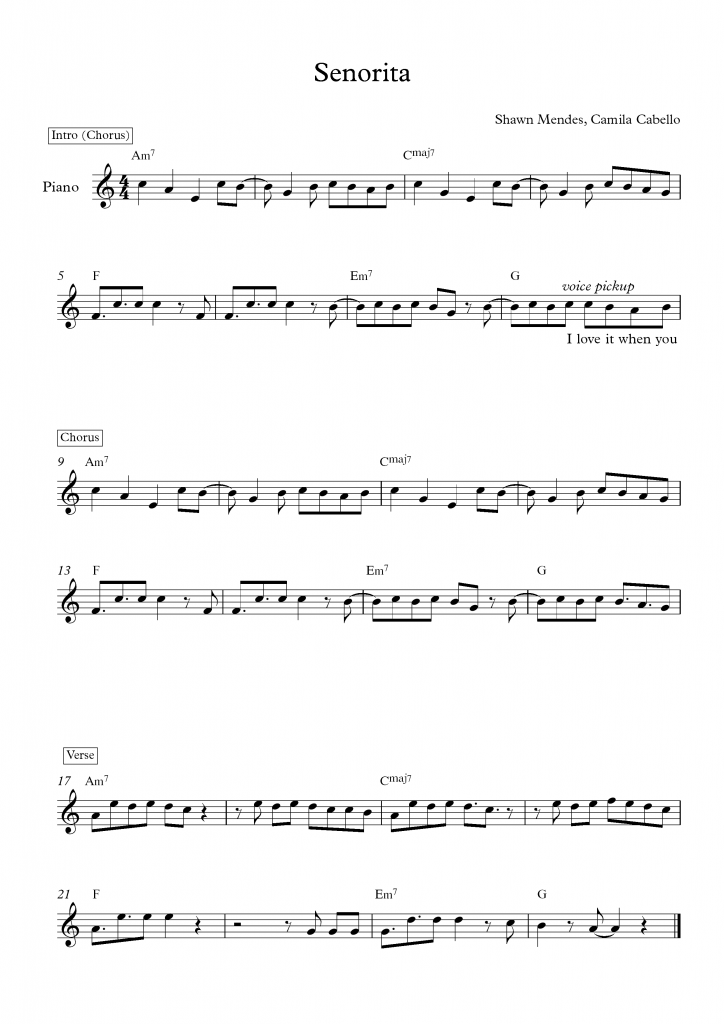
She listens again and tries to determine what kind of style or groove predominates.
She hears that the guitar and the bass guitar carry the groove and goes on to make a pattern playable on the piano that closely resembles what they are doing.
Senorita left hand (lh)
She then makes an arrangement using her own ideas/patterns as well as those she obtained listening to the song; surface level ii).
She goes on to apply the same pattern to Camila Cabello – Havana , another piece with a similar sounding style/groove; second level v).
She could even go and apply the LH adaptation of Havana to Senorita.
2) guitarist in a cover band needs to learn particular solo to Journey – Don’t Stop Believin’.
He transcribes the solo:
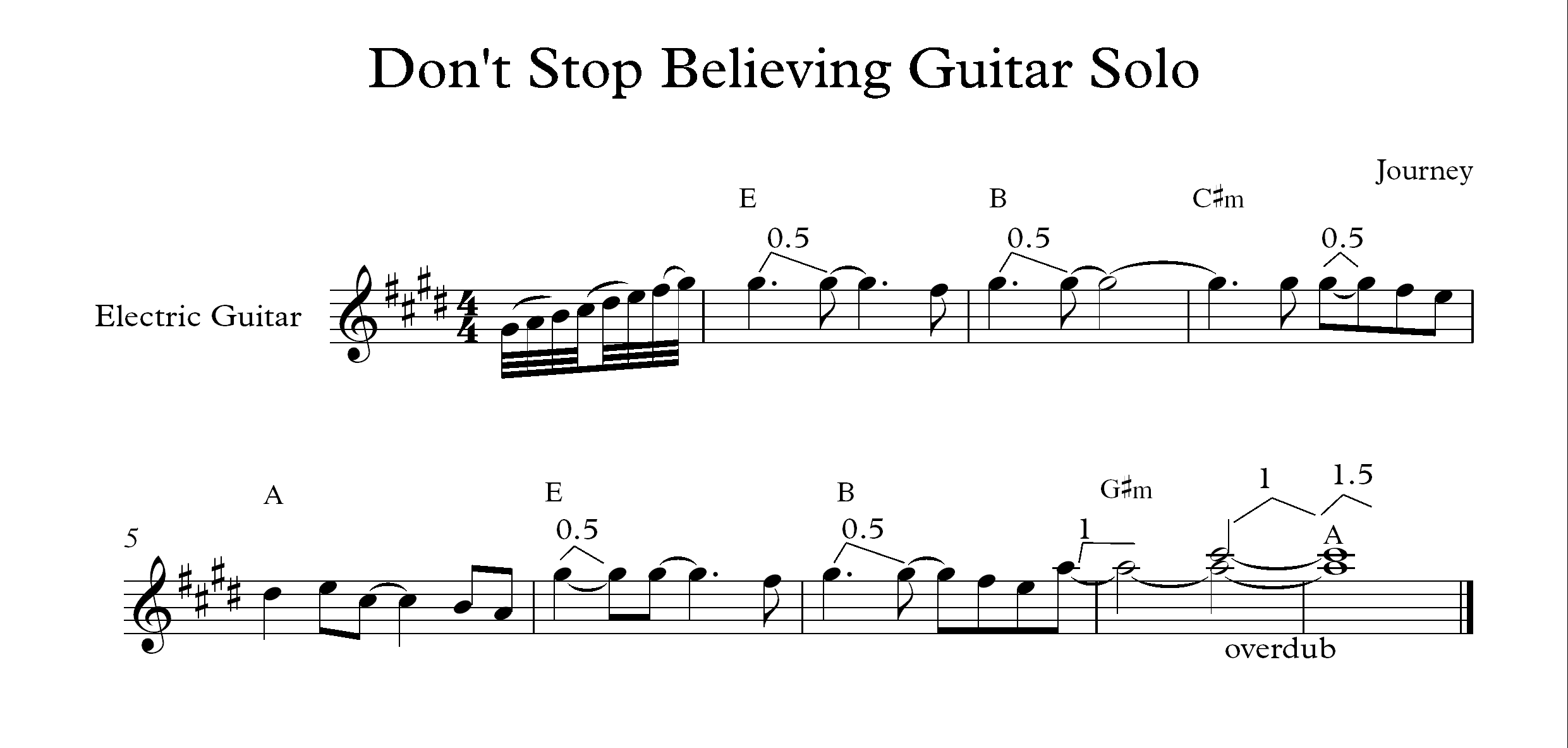 checks it against others; second level vi):
checks it against others; second level vi):
Demo 8.1 Comparing Transcriptions
then corrects his transcription:
3) saxophonist wants to learn jazz and transcribes the solo in John Coltrane – Goldsboro Express
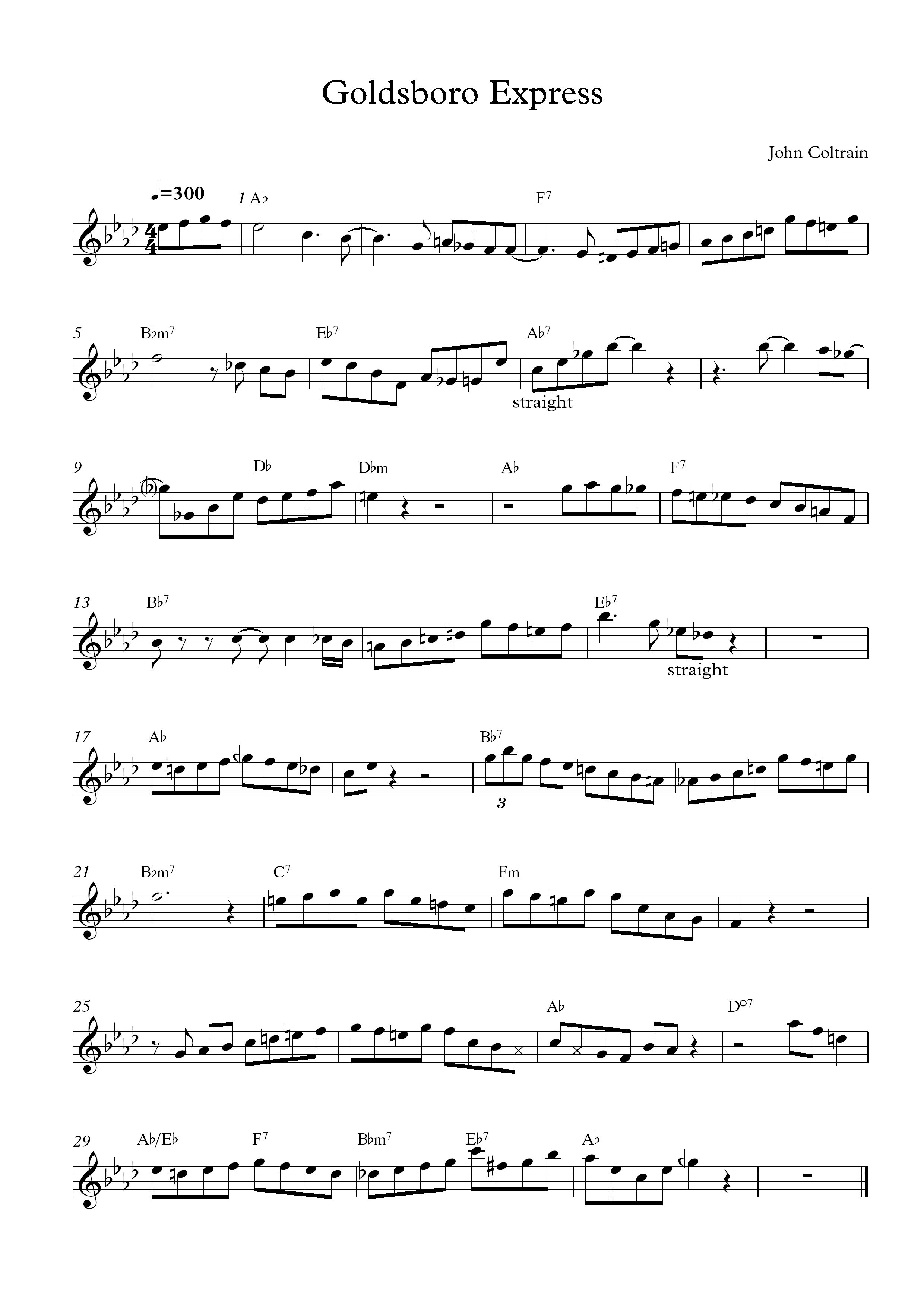 Then goes on to:
Then goes on to:
play it along with the recording; surface level i)
play it in a different key. (or several different keys); second level iv)
scat the solo; high level viii)
Demo 8.2 Three levels of transcription follow up
Assignment 8:
This week it is up to you! Where do you struggle as a musician? Are there any practice techniques/routines that I have recommended that you believe could help you out? If you are having troubles deciding what to do here are 2 suggestions to get you started.
1) Transcribe the cello in Beaux Arts Trio – Piano Trio No. 9 II Scherzo (Beethoven WoO 38) then check your transcription against the score.
2) Transcribe trumpet solo to Chet Baker – You’re Driving Me Crazy then do surface level i) and either second level iii) and v) or high level viii)

